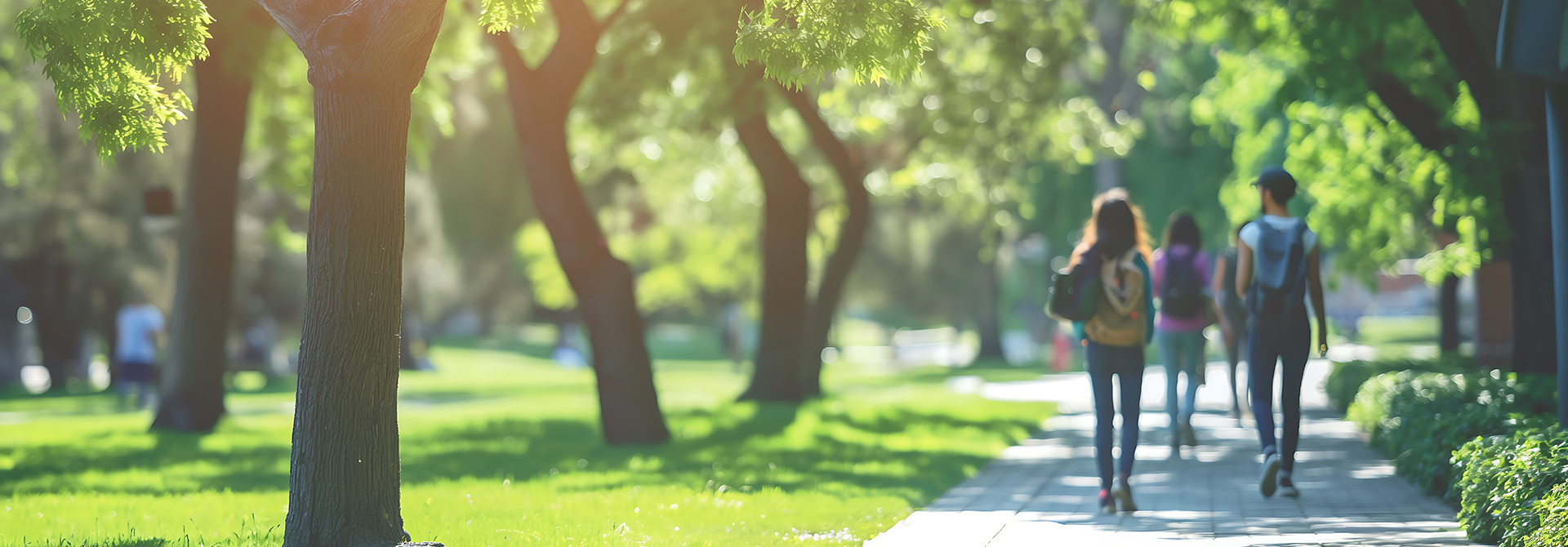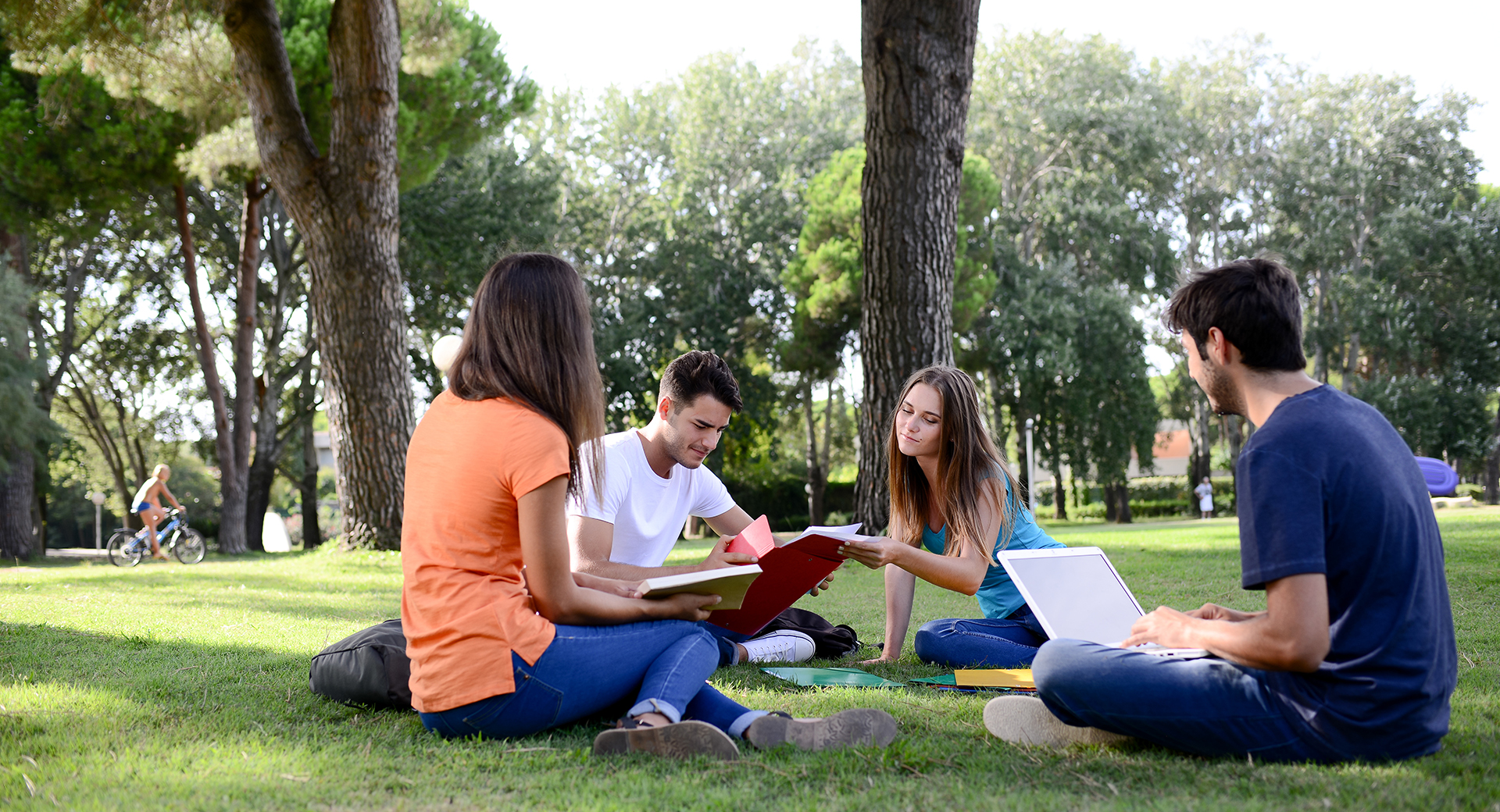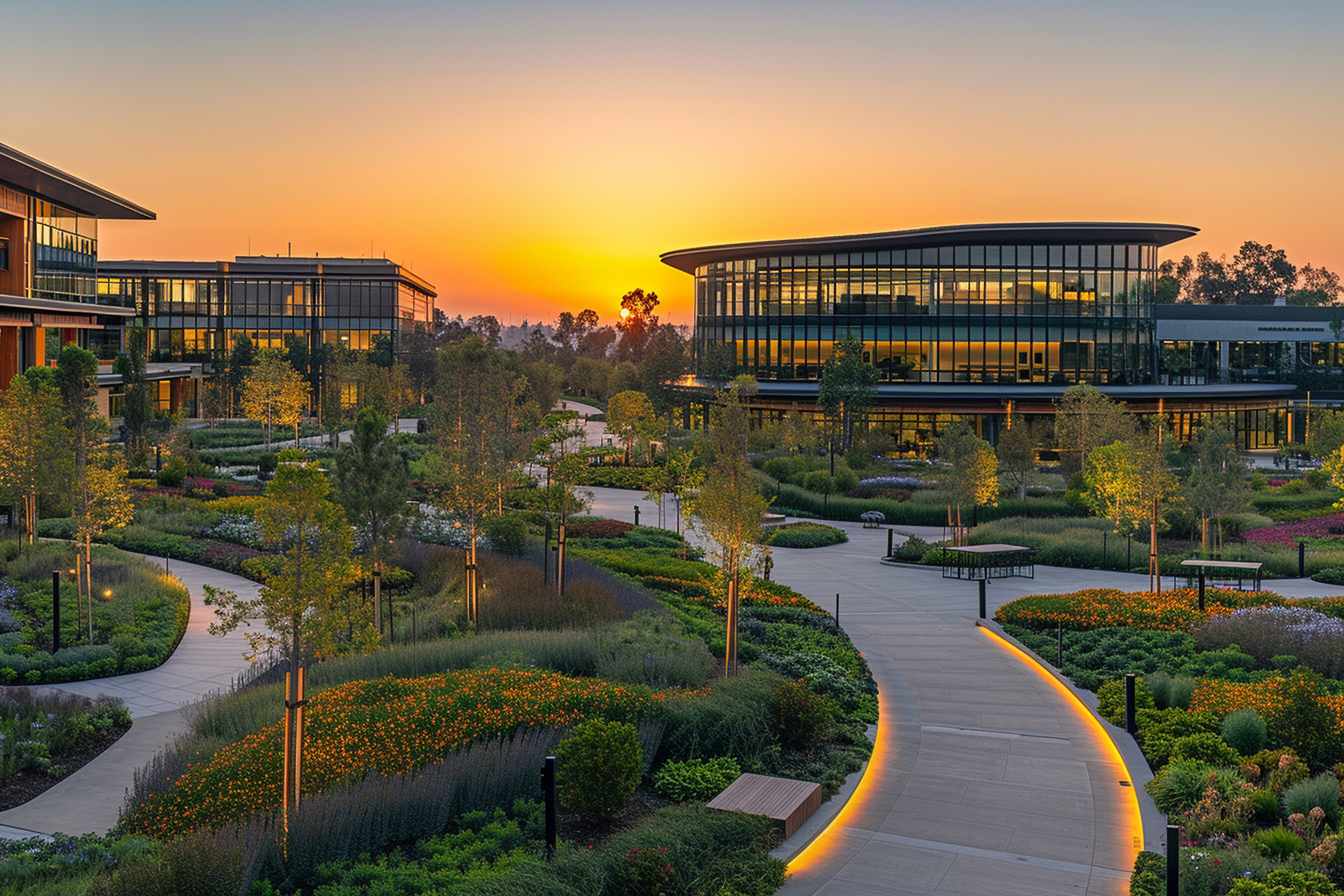Does the campus architecture and landscape—or the campus outdoor built environment—impact student retention? If so, what role do thoughtful landscapes at colleges and universities play?
Due to the changing demographic and evolving student base, a purposeful landscape design is essential to the success of a higher education campus by helping to reduce student stress. Communal spaces are collaborative, active, connected, relaxing, meditative, and even technologically advanced, and are now integral parts of the outdoor built environments at a college or university. Many institutions use their landscape spaces for more than just connecting from one building to another. Outdoor classrooms, science gardens, learning spaces, sports, and activity spaces bring new meaning to landscape architecture for colleges and universities (Kudela & Weinheimer, 2016). Appreciating where people prefer to gather, and understanding contemporary students’ behaviors and learning styles, allows campus landscape spaces to become much more than aesthetic resources to walk by and serve as outdoor social and learning centers (Spooner, 2006).
Being Human
The focus on studying landscape has traditionally been on landscape structure, not human behavior. The concept of processual landscape is the theoretical demonstration of the health-landscape relationship.
Our connection to nature and how it affects us personally makes us human. Our most significant interaction with nature is the landscape we encounter around our homes, community parks, and local reserves. For college students, it is the landscape of their chosen university campus. How humans respond to that landscape can be based on culture, religion, the size of the community they were raised in, what part of the state they are from, and their country of origin, among other reasons. Understanding how these human-nature interactions work may help explain why landscapes can be so crucial to the success or failure of college students. The failure is not always the student’s fault—in many cases, it is the university’s responsibility to recognize this relationship and not provide the nurturing environment students need.
The focus on studying landscape has traditionally been on landscape structure, not human behavior. The concept of processual landscape is the theoretical demonstration of the health-landscape relationship. A processual landscape is the idea of landscape as a process, and the perceiver of landscape as a cultural agent who considers landscape to be a social product. The perceiver plays a vital role in interpreting landscape through their collective history, personal stories, and—in short—cultural background. The perceiver of a landscape is an organic agent and a body that moves through the landscape and is in motion during its experience. Perception is the key to explaining the informal relationship between us and our landscape (Gibson, 1979). Nature restores mental functioning in the same way that food and water restore our bodies. It reflects what neuroscientist Candice Pert said, “What you are thinking at any moment is changing your biochemistry.”
The Human-Nature Relationship
The human-nature relationship is a powerful way to cope with the many stress-inducing events in our lives. When students first set foot on a college campus, they bring a whole set of cultural, social, and family-related issues which can lead to emotional, mental, and physical concerns. One way college students can help reduce these stress-related worries is to connect with the campus landscape. This connection can help reduce stress by providing a relaxing environment, which may help with other mental health and well-being issues. A human’s first reaction to landscapes is an emotional response related to our need for safety and survival, a biological reaction developed during our evolutionary period. These emotional responses are why providing a well-thought-out managed landscape on a college campus is important.

Nature has been shown to provide humans with a place to relax and unwind from their daily stresses and allow them to restore their energy and creative juices. If nature has this power, what roles do university landscapes play in doing the same for college students? Even though campus landscapes do not directly replace our natural environment, they can represent parts and pieces to those who choose to enjoy the landscapes for what they are: a place to de-stress and to re-focus. Campus landscapes cannot be everything to everyone, but they can be very special to many people who visit, work, and live on campus. Those who choose to enjoy the landscape do not necessarily know why they feel more peaceful, but the fact that they are relaxed and less stressed is enough to be better students, which should be an important goal of the campus landscape.
There is growing evidence to suggest that exposure to natural environments can be associated with mental health benefits. Proximity to green space has been associated with lower levels of stress (Thompson et al., 2012) and reduced symptomology for grief and worry (Beyer et al., 2014), while interacting with nature can improve cognition for students with attention deficits (Taylor & Kuo, 2009) and individuals suffering from depression (Berman et al., 2008). In education settings, recent studies have described a restorative effect connected with direct or indirect exposure to trees and other forms of vegetation on students across age groups (Li & Sullivan, 2015). Perhaps surprisingly or not, academics know very little of the environments where they and their students spend so much time.
Assessing Student Success
When the issue of student retention first appeared on the higher educational radar screen some 40 years ago, student attrition was typically viewed through the lens of psychology. Student retention, or the lack thereof, was seen as the reflection of individual attributes, skills, and motivation. Students who did not stay were considered less able, less motivated, and less willing to accept the benefits that college graduation was believed to bestow. Students failed, not institutions. This thought is called “blaming the victim” (Tinto, 2006).
The most common strategies to improve retention and graduation rates are financial and academic, such as revising the financial aid criteria, investing in academic and advisory services, and revising curricula and programs. However, sometimes it must be remembered that a valuable asset for student success can be the physical campus and its surroundings. A supportive physical learning environment can enrich students’ college experience, contribute to a sense of belonging, and respond to their social and emotional needs (Kenney et al., 2005). Leaving is not the mirror image of staying. Knowing why students leave does not tell us—at least not directly—why students persist. More importantly, it does not tell institutions what they can do to help students stay and succeed (Tinto, 2006).
Attending a university is supposed to be a very challenging experience that could change the life course for students. The first year is the most critical for college adaptation because of the many possible adjustment difficulties it can generate (Clinciu, 2013). The pressures of getting top grades, balancing extracurricular activities with studying, and spending time with family all add up. Also, students manage another identity in the digital world. Social media platforms are another thing to keep up with and are often loaded with stress-inducing comparisons, gossip, and bullying (Carlson, 2016). Stress may even cause students to drop classes or, worse, drop out of school. Educators need to recognize the significant impact stress has on teens and young adults, and work to create a supportive educational environment in and out of the classroom, including the campus outdoor built environment (Carlson, 2016). There are many ways to combat stress—from counseling to medications—but one method often left out is connecting with nature, and the easiest way for college students to be in nature is through a thoughtful and well-planned landscape.
It’s Not Always Easy
Growing evidence shows administrators have overlooked the school landscape’s impact on student academic performance. The cost of this oversight is that millions of students are trying to learn in settings that may be significantly less supportive than they might otherwise be (Li & Sullivan, 2015). Being a college student often comes with struggles, like homesickness, poor time-management skills, and impostor syndrome. Add a global pandemic to the mix, which disrupted students’ education, wiped out their finances, and upended their social support systems. The stage is set to experience many psychological repercussions. Under normal conditions, the risk of behavior disorders among college students is high as they transition to adulthood, but those were not normal conditions. Students worldwide had to leave campus suddenly, take classes remotely, and abandon their everyday interactions with friends, all because of a global public health crisis (Bencks, 2020).
Getting Back to Nature
There is no argument that stress is a meaningful concept, and that stress reduction is aided by natural environment experience (Kaplan, 1987). Quite obviously, anything that aids in the management of stress is desirable. Campus nature is multidimensional. Not only does it have height, width, and depth, but campus nature also has taste, odor, sound, texture, and visual appeal. Humans develop in nature, and when they are lost or stressed, they have the instinct to get back to the one thing they can count on to help find themselves, feel safe, and recover; that is nature.

References:
Bencks, J. (2020). How are College Students Coping with the Stress of Coronavirus? Brandeis Magazine, Brandeis University, Waltham, MA.
Berman, M. G., Jonides, J., & Kaplan, S. (2008). Cognitive Benefits of Interacting with Nature. Psychological Science, Volume 19 – Number 12. 1207–1212.
Beyer, K., Kaltenbach, A., Szabo, A., Bogar, S., Nieto, F. J., & Malecki, K. (2014). Exposure to Neighborhood Green Space and Mental Health: Evidence from the Survey of the Health of Wisconsin. Int. J. Environ. Res. Public Health 11, 3453–3472.
Carlson, D. (2016). 3 Ways Stress Negatively Affects Student Performance. Penn Foster Inc. Scranton, PA.
Clinciu, A.I. (2013). Adaptation and Stress for the First Year University Students, Social and Behavioral Sciences, Transilvania University of Brasov. 718-722.
Gibson, J.J. (1979). The Ecological Approach to Visual Perception. New York, NY: Psychology.
Kaplan, S. (1987). Aesthetics, Affect, and Cognition: Environmental Preference from an Evolutionary Perspective. Environment and Behavior Volume 19, Issue 1.
Kenney, R., Dumont, R., & Kenney, G. (2005). Mission and Place: Strengthening Learning and Community Through Campus Design. Praeger Publishers.
Kudela, T., & Weinheimer, D. (2016). 10 Reasons Good Landscape Design is a MUST HAVE on Campus. Landscape Design for Higher Education. 1-6.
Li, D., & Sullivan, W.C. (2015). Impact of Views to School Landscapes on Recovery from Stress and Mental Fatigue. Landscape and Urban Planning. 149-158.
Spooner, D. (2006). Campus Design for the Net Generation. University of Georgia, College of Environment and Design in Athens. 1-5.
Taylor, A. F., & Kuo, F. E. (2009). Children with Attention Deficits Concentrate Better After Walk in the Park. National Library of Medicine. 402–409.
Thompson, C. W., Roe, J., Aspinall, P., Mitchell, R., Clow, A., & Miller, D. (2012). More Green Space is Linked to Less Stress in Deprived Communities: Evidence from Salivary Cortisol Patterns. Landscape Urban Planning. 221–229.
Tinto, V. (2006). Research and Practice of Student Retention: What Next? Pell Institute for the Study of Opportunity in Higher Education. 1-19.
Kevin Dilliard is a certified arborist and director of landscape management and sports turf at Southern Methodist University in Dallas, TX. He can be reached at [email protected].



